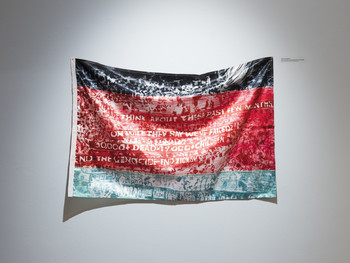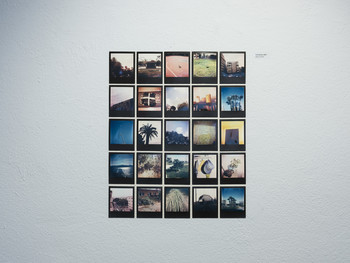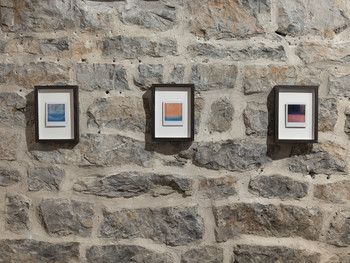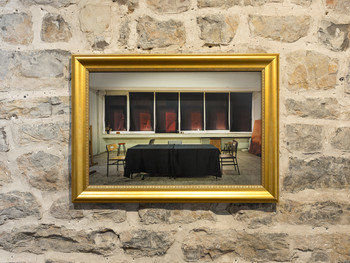Building Libraries
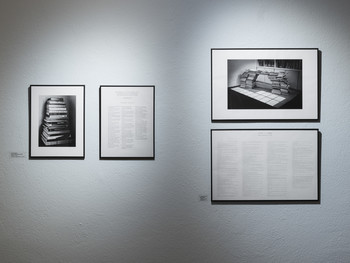
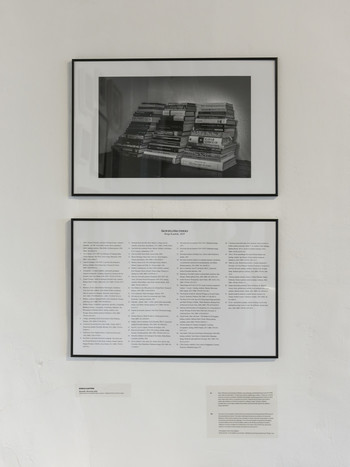
The Bridge, 2023
The Tower: A Suggestion for a Library, 2024
*Monument, 2025
Digital print photo, index on paper
The series began during the pandemic, when Borga Kantürk reflected on the uncertain future of physical books and the question of whether a book’s value lies in its tangible presence or in the ideas it carries. In Building Libraries, the artist arranges books from personal or institutional collections into architectural forms and photographs the construction in black and white. These images are accompanied by indexes that catalogue the books, emphasising the relationship between the
object, its representation and its documentation.
The Bridge was produced using books from K2 Contemporary Art Center’s library in Izmir, which had survived a flood and a fire, and was relocated in 2020 after the building was damaged from the earthquake and deemed unsafe. The Tower: A Suggestion for a Library was produced from the artist’s personal collection and curated in a way that makes the index function as a guide for creating an artist book.
The series addresses the precarious existence of books and libraries in Turkey, where collections are constantly in motion, relocated, stored away or lost due to economic and institutional challenges. The most recent iteration, produced for this exhibition, draws on the Škofja Loka Museum’s internal collection of books compiled in the Department of Art History office, itself in flux, with books added or moved due to staff changes, relocations and other factors.
* The artwork from the series Building Libraries (Monument) is on display in the Museum Living Room of the Škofja Loka Museum.
Becoming a Survivor, 2005
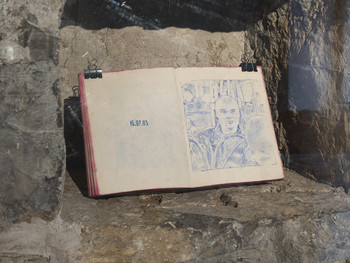
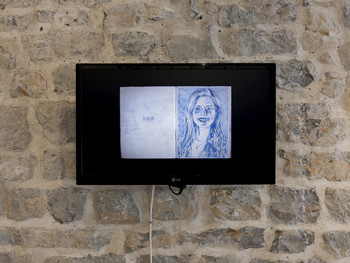
Video documentation; notebook
Becoming a Survivor was developed during a 90-day residency in Helsinki. Each day, the artist bought a newspaper, chose one image and transferred it into a notebook using blue carbon paper – a retro material once used for duplicating documents. The city had emptied for the summer holidays and this daily ritual became both a means of endurance and a record of solitude, recalling the setting of Danny Boyle’s post-apocalyptic film 28 Days Later (2002), in which London, normally teeming with people, appears eerily deserted. The project was put together in two forms: a printed edition and video documentation of the notebook.
Concrete Cover, 2023
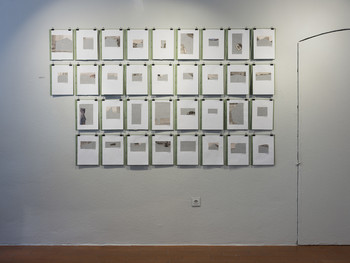
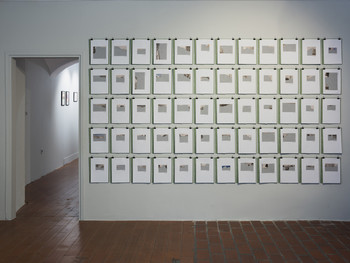
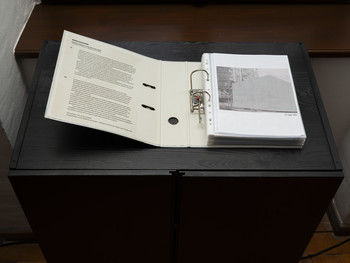
Installation; *digital prints in a binder
Concrete Cover documents the period between 6 February 2023, when two major earthquakes hit southern Turkey, with over 50,000 estimated deaths, and June 2023, when the Turkish general elections took place. During this time, Borga Kantürk would buy a daily newspaper and collect photographs of the destruction, eventually gathering a total of 94 images, most in grayscale. As he observed, such images gradually disappeared from the press, as media attention shifted from the earthquakes to
electoral promises and flashy groundbreaking ceremonies.
Mounting the newspaper clippings onto white A4 sheets of paper and stamping each with its date, the artist additionally numbered and filed each image in separate office folders, evoking the legal documentation of lost properties, deeds and civil rights. He used grey concrete paint and applied it on the photographs in geometric shapes, brushing it only over the debris of destroyed buildings while leaving those not irreversibly damaged by the earthquake untouched. The painted surface mimics the
texture of concrete but functions like plasterboard – a superficial layer that conceals what lies beneath.
* A separate dossier with digital prints of each file was produced specifically for this exhibition, allowing visitors to browse the work on-site as an archive. The artwork Concrete Cover (photocopies in a binder) is on display in the Museum Living Room of the Škofja Loka Museum.
Black Lives Matter (USA Women’s National Soccer Team Protest), 2025
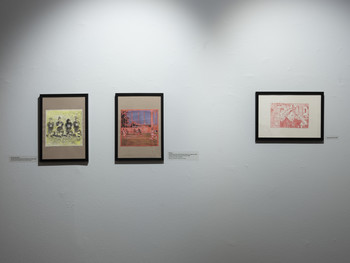
Coloured pencil on paper
Women’s soccer in the U.S. has a history as a protest sport. During matches in the 2020s, players showed solidarity with the Black Lives Matter movement by wearing T-shirts with the BLM slogan and kneeling during ceremonies, drawing attention to police brutality and systemic racism.
Respect (Women’s Euro 2021 Qualifiers: Malta vs. Denmark, Ceremony Protest), 2025
Coloured pencil and pastel on paper
On 22 September 2020, before kickoff in the Women’s Euro 2021 qualifier between Malta and Denmark, players from both teams took a knee in silent protest. The gesture is a powerful stance against racism, homophobia and other forms of discrimination, and has since become a global symbol of resistance.
Naki (Dersim '62), 2025
Drawing on tracing paper with red carbon paper
Former Kurdish footballer Deniz Naki drew controversy and faced racism in 2014, while playing for a club in Ankara, for his “Dersim 62” tattoo. The inscription references the province’s Kurdish name and license plate number before it was renamed Tunceli under Turkification policies in 1935. Dersim (the present-day Tunceli) is a province in eastern Turkey with a largely Kurdish and Alevi population, historically subjected to suppression, including the 1937–1938 massacre, during which thousands were killed or displaced. The tattoo and its documentation allude to the historical suppression of Kurdish culture and identity in Turkey, as well as to its persistence today.
Fowler, 2009
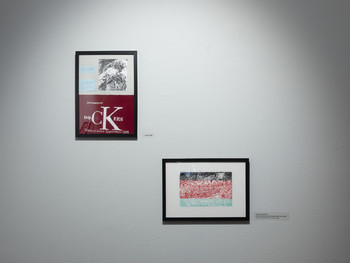
Drawing on paper, acrylic on fabric, collage
In 1997, Robbie Fowler, a former Liverpool player, revealed a T-shirt bearing the slogan “Support the 500 Sacked Dockers,” designed using Calvin Klein’s “CK” logo, after scoring a goal in a European Cup Winners’ Cup match against a Norwegian team. He wore it under his jersey to show solidarity with 500 Liverpool dockworkers dismissed during the Liverpool dockers’ dispute (1995–1998), a labour protest against the precarization of working conditions. Fowler was fined for this act of support, while the dispute itself became emblematic of resistance to neoliberal labour practices.
Flag for Palestine (Celtic FC Fans Protest), 2024, 2025
Drawing with black, red and green carbon paper on paper; print on fabric
Celtic FC’s defiant fans have repeatedly challenged UEFA’s censorship of pro-Palestine symbols in stadiums. In one protest, they unfurled a banner that read:
"Think about these past few months
Oh will they say we’ve failed
*30,000+ dead – 19,000+ children*
End the genocide, end Zionism."
In 2025, the artist produced a print of this drawing in the form of a flag.
Black Frames, 2025
Polaroid photographs
Black Frames presents the artist’s visual diary of 25 moments, captured on Polaroid film. The work references Eduardo Galeano’s Children of the Days: A Calendar of Human History (published in Turkish as And the Days Started Walking), where each day serves as a point of reflection. In Kantürk’s work, “walking” refers both to the passage of time and to his own movement through it. No matter what, the artist maintains a daily practice of taking a single photograph,
with every image recording his engagement with the world and his experience of time, focusing on what captures his attention on that particular day.
The black Polaroid frames draw on Constructivism and Kazimir Malevich, while visually separating each image and emphasising it as a distinct moment within the artist’s daily ritual.
After Rothko I–II–III, 2020
Polaroid photographs
After Rothko is part of Kantürk’s ongoing exploration of the increasing bureaucratisation of academia. In 2019, the Dokuz Eylül University’s Faculty of Fine Arts departments were relocated to a peripheral campus due to the seismic risk at their original premises. The new building, originally designed as a rectorate and intended for offices, lacks proper studios for fine art education. Additionally, pandemic restrictions at that time suspended hands-on practices, in-person encounters
and entrance exams. As a result, art education and creative production were largely reduced to administrative tasks.
Kantürk examined the challenge of creating art without traditional studio practices. During this period of heightened hygiene regulations, he observed the faculty’s restrooms, where transparent, cube-shaped soap dispensers were regularly refilled with soaps of different colours. The layering of these soaps (red, green, blue etc,) created subtle colour transitions, which the artist recognised as ready-made material echoing the paintings of 20th century abstract painter Rothko, who employed
similar division in his colour fields. The series reflects the constrains of a system in which art education and practice is limited by both bureaucracy and institutional regulations.
Jury, 2018
Colour photography
Borga Kantürk, an alumnus and a long-time member of the Department of Painting at the Dokuz Eylül University’s Faculty of Fine Arts, often examines themes of academia and art education in his work. Over the past decade, he has focused on the increasing bureaucratisation and loss of human element in artistic training in Turkey.
Jury shows a room prepared for admission interviews during the now-discontinued second stage of the Department of Painting’s entrance examination. After passing the initial drawing test, candidates presented their portfolios to a jury of faculty members. The photograph captures the moments before this encounter between students and professors. The arrangement of the table evokes the symmetrical composition of Leonardo da Vinci’s The Last Supper, while the worn walls,
flooring and mismatched chairs emphasise the ordinariness of the space.
This stage of the examination was suspended during the pandemic and has not been reinstated. Admissions are now based solely on documentation, except at the doctoral level. In its first installation, the artist displayed the image in an ornate classical frame, similar in style to the one seen in the current exhibition, and it was accompanied by the drawing supplies used in the exam, such as pencils and erasers.

